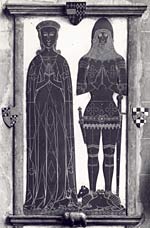sources » The Lords Appellant
The Lords Appellant and the forfeitures of 1397

Thomas of Woodstock with a swan brooch from the St Albans Book of Benefactors (London, British Library Cotton MS Nero D.viii, f. 0)
The five great magnates known as the Lords Appellant were:
- Thomas of Woodstock, duke of Gloucester (1355-97), youngest son of Edward III and uncle of Richard II
- Richard Fitzalan, earl of Arundel (1346-97)
- Thomas Beauchamp, earl of Warwick (1337/9-1401)
- Henry Bolingbroke (1366-1413), earl of Derby, afterwards Henry IV, the king's first cousin
- Thomas Mowbray, earl of Nottingham (1366-99)
In November 1387, Gloucester, Arundel and Warwick, frustrated by differences over foreign and domestic policy, and motivated by personal jealousies over influence, power and lands, first launched accusations (an appeal of treason) against some of the king's favourites. A month later Derby and Nottingham joined them. At Radcot bridge, not far from Oxford, they won the brief civil war of December against an army led by the king's favourite, Robert de Vere, duke of Ireland. These political and military actions resulted during the 'Merciless Parliament' of spring 1388 in the personal humiliation of the king. Eight of his closest intimates, among them his former tutor, Sir Simon Burley, were executed. De Vere and two others escaped death by fleeing abroad, never to return. Upwards of forty men and women were dismissed from court.

Memorial brass of Thomas Beauchamp, earl of Warwick, and Margaret, his wife, from their lost tomb in St Mary's Church, Warwick
Ten years later, now in a much stronger position through his French alliance, Richard exacted his revenge. In July, Gloucester, Arundel, and Warwick were arrested and all were condemned as traitors in the Parliament of September. Arundel was condemned and executed on the same day on Tower Hill. Thomas Arundel, archbishop of Canterbury, was exiled. Gloucester was already dead, murdered in custody in Calais, probably suffocated under a mattress. Warwick's life was spared, but he and his wife were exiled for life to the Isle of Man. Bolingbroke and Mowbray (now the dukes of Hereford and Norfolk) escaped Richard's wrath until the following year. In 1398 they quarreled. Richard at first agreed to their duel, but then forbade it, exiling the contestants and setting in train the events which led to his deposition (see On stage).
The condemnations of 1397 had very important implications for the growth of Richard's treasure at the end of his reign. Besides death or exile, and the other terrible penalties imposed upon traitors and their heirs, there was the forfeiture of all their lands and goods to the crown. Many objects listed in the treasure roll can be shown to have belonged to Gloucester, Arundel and Warwick and their wives. Their former possessions are not identified as such, but comparison with private documents and with the central crown records can reveal many of the secular and chapel goods seized by Richard. There is nowhere a complete list; the documents are scattered and fragmentary. A number of other objects seized in this way will probably always remain concealed.
The central financial records of the crown, among them the receipt and issue rolls kept in the Exchequer, help to piece together this fascinating story. Once officials had collected up valuables of every kind (tapestries, furs, robes, armour, books, and so on, as well as gold and silver), they were brought to Westminster, then appraised by expert tradesmen from the city. Trussed in canvas and cord they were loaded on carts to be taken to the king at Windsor for him to take his pick. Fifteen carts and horses under escort were needed to transport the valuables of Gloucester and Arundel alone. A huge quantity of silver vessels were among items seized from Archbishop Arundel. In this one instance the treasure roll reveals the source. The objects were broken up, ready to be melted down and remade. Some new vessels for Richard's household had already been made from this loot before 1399 (see household plate).
